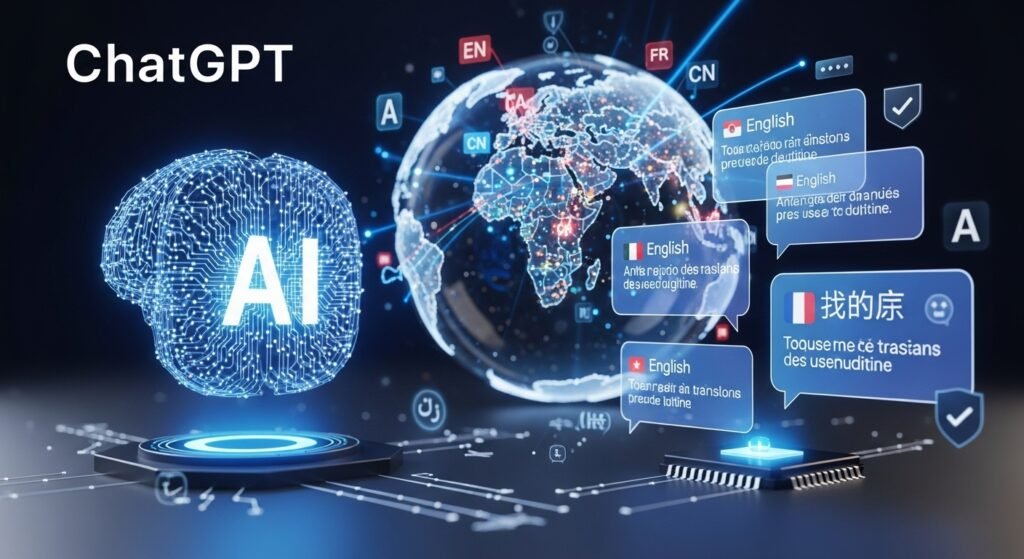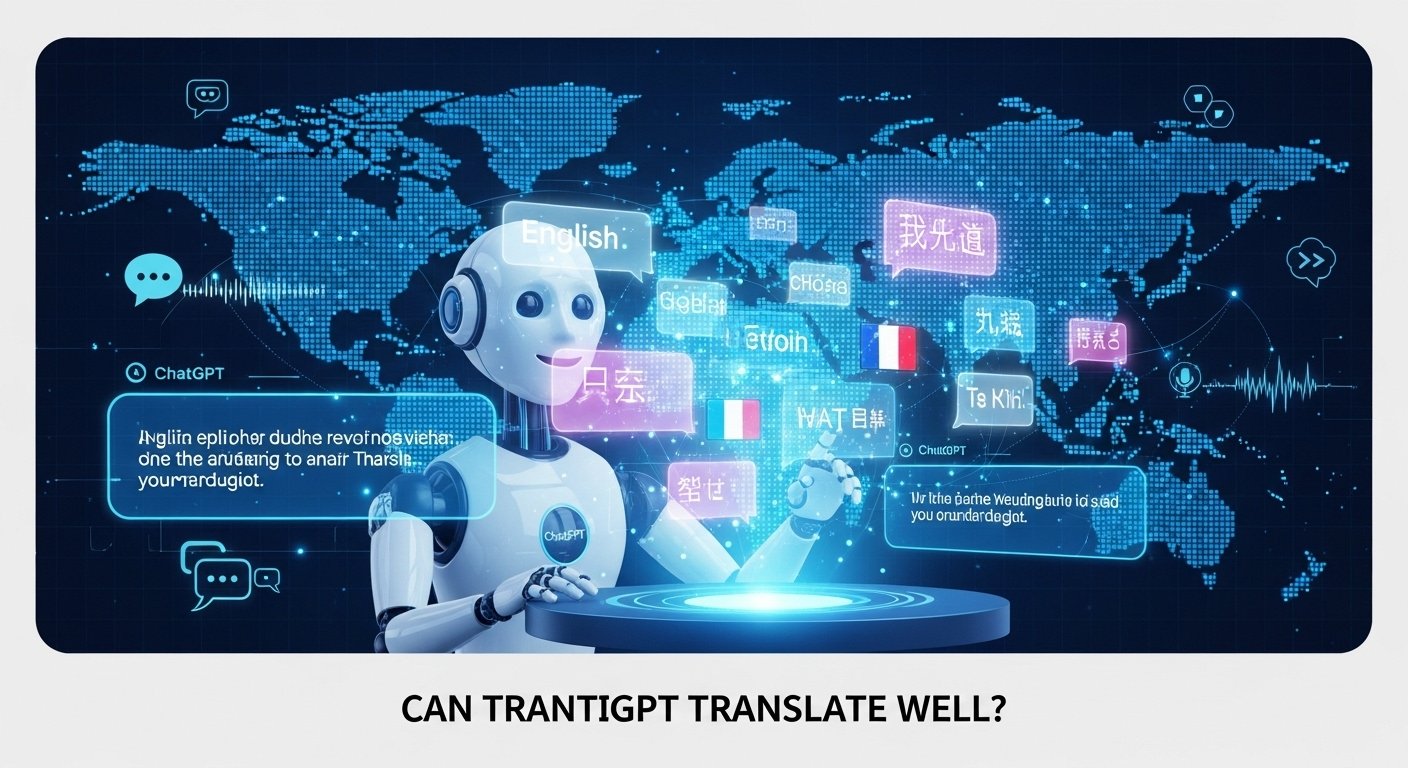ChatGPT, developed by OpenAI, has become a popular tool for tasks ranging from answering questions to generating text. Its translation capabilities have sparked interest, but is it truly effective for translations?
How ChatGPT Handles Translations
ChatGPT translates text by processing prompts like “Translate ‘Where is the bathroom?’ into Italian” or “Translate ‘I love you’ into French.” It uses its large language model, trained on vast datasets, to understand and convert text across languages. According to a study by Ampere Translations, ChatGPT can produce translations close to human quality in some cases, particularly for high-resource languages.
To use ChatGPT effectively, you need clear prompts. For example:
- “Translate ‘Thank you’ into Japanese.”
- “Convert this Python code to JavaScript.”
This flexibility makes ChatGPT accessible, but its performance depends on the language pair and context.
Comparing ChatGPT with Other Translation Tools
ChatGPT vs. Google Translate
Google Translate has long been the go-to for machine translation, using advanced algorithms to handle a wide range of languages. ChatGPT, however, leverages its conversational AI to produce human-like translations. A PCMag study from February 2024 found that ChatGPT’s free version doesn’t always outperform Google Translate, but its paid version (using GPT-4) can be competitive, especially for nuanced translations PCMag.
For instance, ChatGPT accurately translated “car keys” into natural phrases, avoiding literal translations like “keys of the car,” as noted by HowToGeek HowToGeek. However, it struggles with slang. Ampere Translations reported that ChatGPT mistranslated the Spanish slang “primo” as “cousin” instead of “brother” or “mate,” while Google Translate often handles such nuances better.
ChatGPT vs. DeepL
DeepL is known for its high accuracy and natural tone. A comparison by Ampere Translations showed that both ChatGPT and DeepL accurately translated the German phrase “Ich bin fix und fertig” into English, but DeepL offered more informal tone options. DeepL generally maintains the original text’s style better, while ChatGPT may overuse passive voice, leading to longer, less natural sentences Ampere Translations.
Reddit users have mixed opinions, with some preferring ChatGPT for languages like Hungarian, while others favor DeepL for its precision.
Other Translation Tools
Tools like Microsoft Translator and Amazon Translate exist but are less popular. They use machine learning but may not match ChatGPT or DeepL’s accuracy for high-resource languages. ChatGPT’s unique ability to explain translations or revise based on feedback sets it apart, as noted by users on Reddit.
| Tool | Strengths | Weaknesses |
|---|---|---|
| ChatGPT | Natural translations, explains choices, code translation | Struggles with slang, low-resource languages |
| Google Translate | Wide language support, handles nuances well | Less interactive, literal translations |
| DeepL | High accuracy, natural tone | Limited language support compared to Google |
Accuracy and Quality of ChatGPT Translations

High-Resource Languages
ChatGPT shines with high-resource languages like English, Spanish, French, and German. Rapid Translate noted that it maintains context and produces natural translations for these languages. It also handles cultural references well, making translations more relevant. For example, it can translate idioms like “the last straw” correctly, as per HowToGeek.
However, it’s not flawless. Ampere Translations found that ChatGPT’s translation of “Magistrates’ court” into French was less accurate than Google Translate’s, highlighting issues with technical terms.
Low-Resource Languages
ChatGPT struggles with low-resource languages due to limited training data. An arXiv study from 2023 found that ChatGPT lags behind Google Translate for languages like Romanian or Guarani, with a 46.4% lower BLEU score for English-Romanian compared to English-German arXiv. Reddit users also reported issues with languages like Georgian and Slovenian, where ChatGPT produced errors or gibberish.
Handling Nuances and Context
ChatGPT’s contextual understanding is a strength but also a weakness. It can recognize idioms and slang in some cases, but it often misinterprets cultural nuances. For example, Reddit users noted that ChatGPT excels in Spanish-English translations for slang but fails in Catalan-Spanish or English-Polish translations, taking phrases too literally.
Additionally, ChatGPT may overuse passive voice or produce lengthy sentences, diluting the original tone, as per Ampere Translations. This can make translations feel less natural compared to human or DeepL outputs.
Use Cases for ChatGPT in Translation
Translating Text
ChatGPT is ideal for casual text translations, such as emails, social media posts, or articles. It’s useful for quick drafts that can be refined later. For example, it can translate a blog post from English to Spanish, providing a starting point for further editing.
Translating Code
ChatGPT can translate code between programming languages, like converting Julia to Python, with high accuracy, as noted by MachineLearningMastery. This makes it valuable for developers working across multiple languages.
Assisting Non-Native Speakers
ChatGPT helps non-native speakers by providing translations and explanations. For instance, it can translate a greeting into Hindi and explain its tone, as shared by Android Authority. This is useful for language learners or cross-cultural communication.
Limitations of Using ChatGPT for Translation
Accuracy Issues
ChatGPT’s accuracy varies. The arXiv study found that GPT-3.5 produces more errors and hallucinations, though GPT-4 improves significantly, matching commercial tools even for distant languages. However, errors persist in complex or low-resource language translations.
Contextual Understanding
ChatGPT’s limited contextual grasp can lead to translations that miss the intended meaning or tone. For example, it may translate a formal document too casually, as noted by LanguageIO.
Data Privacy and Compliance
ChatGPT stores user inputs, raising concerns for sensitive content like legal or medical documents. LocalizeJS warns that this makes it risky for high-stakes translations in LocalizeJS. Enterprises should avoid using ChatGPT for confidential data without strict controls.
Future of AI in Translation
Advancements like GPT-4 have boosted ChatGPT’s translation performance, making it comparable to commercial tools, as per the arXiv study. Future AI models may handle more languages and contexts with greater accuracy. However, human translators remain crucial for nuanced, high-stakes tasks, as emphasized by Language Insight.
Recent updates as of July 2025 focus on user interface improvements rather than translation-specific enhancements from OpenAI. Still, techniques like pivot prompting—translating through a high-resource language first—can improve results for distant languages, as noted in the arXiv study.
Conclusion
ChatGPT is a strong contender for translations, particularly for high-resource languages and casual use. It offers natural translations and unique features like code translation and language learning support. However, its struggles with low-resource languages, slang, and data privacy make it less reliable for critical tasks. For best results, use ChatGPT for drafts or informal translations and pair it with human review or specialized tools like DeepL for professional needs.
FAQs
Q: Is ChatGPT better than Google Translate for translation?
A: It depends on the language and context. ChatGPT excels in some cases, like handling slang or explaining translations, but Google Translate is more reliable for a wider range of languages.
Q: Can ChatGPT translate low-resource languages accurately?
A: ChatGPT struggles with low-resource languages due to limited training data, performing better with languages like English or Spanish.
Q: Is ChatGPT good for translating technical or legal documents?
A: No, ChatGPT is not ideal for technical or legal documents due to potential inaccuracies and privacy concerns. Human translators are recommended.
Q: How does ChatGPT compare to DeepL for translation?
A: DeepL often produces more natural translations with better tone, while ChatGPT is more flexible with user feedback and explanations.
Q: Can ChatGPT translate code between programming languages?
A: Yes, ChatGPT can accurately translate code, such as from Julia to Python, making it useful for developers.
